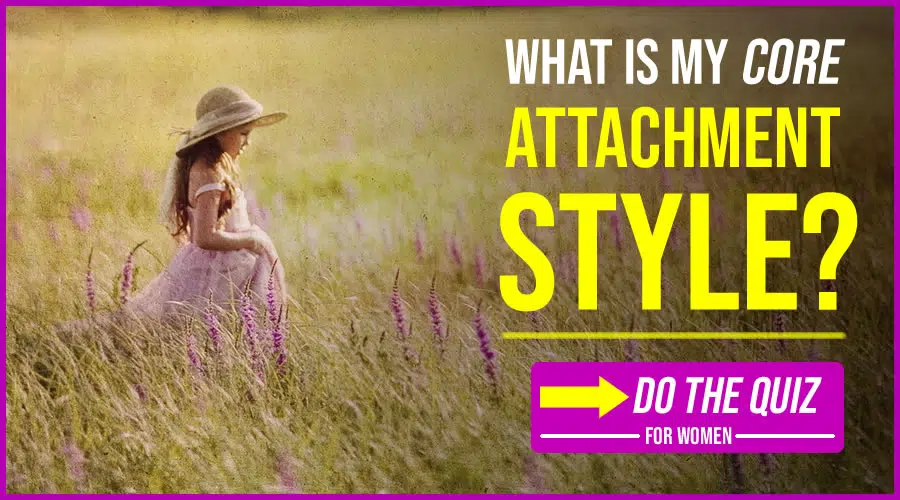Do you find yourself feeling especially stressed and anxious when getting into a romantic relationship?
I understand.
It is a scary thing to enter a new relationship with someone. Someone who will not only demand intimacy with you, but who may also betray your trust.
But would it surprise you if I told you that there’s a large number of people in the world who don’t feel fear or anxiety when getting close to someone or entering a new relationship?
Yep. These kinds of humans exist, and they aren’t the anxious type, they’re what we call “securely attached” people.
But those of us with an anxious attachment style live a very different quality of life than someone with a secure attachment style.
We have quite the challenge. Let me explain.
Table of Contents
What Is Anxious Attachment Style?
Anxious attachment style describes a typical emotional state or pattern that you go to in relationships with others, specifically when you get close to them and experience intimacy with them.
You can look at anxious attachment style as being an equilibrium that your nervous system has developed since infancy for relating to others.
As you’ve probably guessed, this “equilibrium” is not one of ease with relationships, but rather, one of high alert and stress.
If you have an anxious attachment style, also called anxious preoccupied attachment style, then you will experience more stress and confusion when getting close to others.
If intimacy is required of you, you may:
- Feel anxious
- Clam up
- Not want to trust the other person
- Push them away; and
- Assume the relationship will fail
But one thing needs to be clear here: not every single person who thinks they have an anxious attachment style definitely has that specific attachment style.
Many anxiously attached people also have avoidant tendencies, and it’s also possible that you veer into the territory of disorganized attachment.
If you want to be sure of your own attachment style (and get a clear, in depth analysis of your specific core attachment patterns), we have a very special quiz that will do that for you.
It’s super quick, and there are only 10 questions…
(Why is this important? It is because your core attachment style largely dictates and influences what happens in your relationship. Thus it’s imperative you understand your core attachment style!)
What Causes Anxious Attachment Style?
The cause of anxious attachment style, in the simplest sense, is insufficient nurturing in infancy and toddlerhood.
Specifically, you may have had a mother or caregiver who was:
- Inconsistent in responding to you
- May have “tried” to be there for you, but didn’t quite manage to match the intensity of your needs with equal intensity of care and investment
- Emotionally unavailable or “checked out” at times
- Simply not maternal or sensitive enough to your emotional needs
As babies we come into the world highly vulnerable, sensitive and emotional.
The job of our caregivers, if they are to give us the gift of a secure attachment style, is to:
- Drop everything for 1-2 years and prioritise responding to you and your needs
- Help you manage fear
- Help you calm down when you’re upset or angry; and
- Treat you as though every emotion you have is worthy of being heard, responded to and regulated (by an adult)
As you can imagine, this is no small task. Many parents fail at it, not necessarily because they don’t care, but because they don’t have the resources and the awareness to prioritise all that.
So the consequences are shouldered by you, the infant (or the child).
If your caregivers were not able to be sensitively responsive in a consistent way, then your nervous system becomes unable to regulate itself.
So the next logical question is:
How does anxious attachment style present itself? How does it manifest in your life?
Let’s look at some anxious attachment style symptoms right now.
Symptoms of Anxious Attachment Style
- Emotional dysregulation
- Excessive and recurring jealousy when getting close to someone and investing in a relationship with them
- A propensity to either blow up or ‘check out’ when conflict arises
- An unconscious habit of behaving in negative and hurtful ways that push people away
- A tendency to overthink when in a relationship, even when things are going well
- A desire for frequent reassurance in a relationship
- A deep desire for attachment at the same time as not feeling worthy of it
- Immense stress when your partner is away
- Needing almost constant attention to feel safe
- A tendency to attach to people early and easily (See: Why Do I Get Attached So Easily? 6 EXACT Reasons & How To Stop.)
- Constant worry that your man isn’t really committed to you.
If you worry about how committed your man is to you, you can easily find out how committed he is for real with our quiz: “How Commitment Friendly Is He?”
It’s not nice to say, and I don’t take joy in saying this, but as someone with an anxious attachment style, I can tell you that our quality of life is very different from those who are securely attached.
I compare my own patterns or emotional state to that of my husband’s, who is as securely attached as they come, and I see many uncomfortable differences about the quality of our lives.
Let me illuminate some of these painful differences (many of which, by the way, have been greatly reduced throughout 17 years with him by my side):
Secure Person Vs Anxious Person: 7 Shocking Differences
- He has zero social anxiety from the day I first met him.
He feels completely comfortable interacting with anyone and everyone, whilst I would sometimes freeze or basically worry that people wouldn’t like me. - His memory is fully intact. Mine? Well, not only does he remember my own early trauma better than me these days, he remembers all the little details about everything in life more than I do.
Yes, some of this could be due to mummy brain or just having had 3 kids, but some evidence of this memory issue was there before we had kids. - I need reassurance, he doesn’t.
Admittedly, this is also a masculine/feminine difference, but we cannot ignore the fact that it’s also a secure attachment/anxious attachment difference. - He finds it easy to deal with other anxiously attached or avoidant people. I don’t.
- He’s resilient in the face of stress, and the same goes for my sons who are securely attached.
They may still be sensitive, but when confronted with stress, all four of my boys don’t:
– Check out
– Let their stress compound at breakneck speed
– Get angry; or
– Cause others any further hurt
By contrast, when very stressed, there’s a chance I may go quiet and check out (and my husband misses me tonnes when I do that!)
So now that I’ve discussed these differences, the question is: how to heal anxious attachment?
MORE: 12 Anxious Attachment Triggers: How To Recognise & Heal Them.
How To Heal Anxious Attachment Style
Healing anxious attachment style comes down to learning to attach to others again whilst regulating your anxiety.
The painful truth is that most people with anxious attachment either continue causing stress long term in their relationships, or they try to avoid intimacy altogether, causing their relationships to fail or feel more like “friendships”.
So below I have 5 ways to heal anxious attachment style. You don’t have to use all of these ways, you can just pick one or two of them to begin with, and gradually move toward integrating the others.

#1: Consider Whether You Need To Eliminate Toxic And Avoidant People
Ok, so I know that even if someone is an avoidant, you might still love them or want to care for them.
But if someone is an avoidant and toxic, they will just make you more avoidant.
Further still, they’ll break down your self worth even more over time, because they’ll:
- Trigger your fear that you aren’t worthy; and
- They won’t be able to help you change your attachment blueprint or your attachment patterns
#2: Use Anchors for Secure Attachment
This is something I’ve discussed in depth in my article on How To Self Soothe Anxious Attachment In 2 Easy Steps. You can read that article and learn more about anchors for secure attachment when you have time.
Basically, anchors for secure attachment are something you go to when you’re feeling anxious in order to ground yourself in feelings of safety and calm.
You can do this with:
- A song (or songs)
- A movie scene
- A book
- Poetry; or
- Old warm memories

#3: Appreciate And Mimic The Emotional Responses Of Securely Attached People
I’m not asking you to be a copycat here. Rather, I’m asking you to
- Make friends with securely attached people
- Observe how they respond to stressors like work or college deadlines, relationship breakups, relationship conflicts, and natural disasters or traumatic events; and
- Feel deeply into their emotional response and see if you can find resonance in their emotional state.
Ultimately the purpose of this is to come up with a new “self talk” script that you have created through observing securely attached people or even asking them how they manage their stress.
Is there a specific way they calm themselves?
Do they use any particular words, phrases or mantras that make them resilient in the midst of great stress?
Is there something they focus on that you could also learn to focus on too?
Remember this:
Securely attached people have reaped the benefits of resourceful and loving parents.
They’ve gained a huge advantage in life that they likely take for granted and don’t even notice.
But you can also reap the benefits of the good work of their nurturing parents, by learning what they do and how they approach life’s biggest upsets.
Oh, and perhaps even thank these people for existing. There’s a lot you can learn from them! 😉

#4: Nurture Yourself As A Baby
This one sounds weird, so let me tell you what I mean when I say “nurture yourself as a baby’…
I mean:
Go back to when you were a baby, picture yourself as a baby (even hold an old photo of yourself), and feel the absence of the nurturing you longed for.
But how the hell would you remember things from when you were a baby?!
It doesn’t matter that you remember specific events.
What matters is that you feel the emotional quality of what it was like to be you as a vulnerable baby.
Ultimately, every anxiously attached person feels a huge lack of nurturing, even if they cannot put it into words.
If you really have anxious attachment, then you will know exactly what I mean, because you’ll feel it in your bodily memory and in your gut.
I mean, the lack of nurturing is the exact reason you need so much reassurance as an adult.
So:
Go back to you as a baby, and feel the pain of the absent mother or father.
Feel her sorrow and resonate with her. Let those feelings come up (they are deep within your bodily memory, just try to trust me on this!)
When these feelings come up, nurture yourself and hold yourself. Remind yourself that you will be ok, and that you made it (or are going to make it).
#5: If You Have A Pet Or A Child, Give Them Secure Attachment
So after having both pets and babies, I can tell you that they both need nurturing and a ‘mom’.
Nothing groundbreaking there, I suppose.
But due to advice from ignorant people, many moms emotionally abandon both their human and animal babies.
Examples:
- They leave their new baby or even puppy to cry all night
- They assume that small, vulnerable humans and mammals somehow come out of the womb with self soothing capabilities (they don’t!); and
- They forget that their real value as a mother or father is in being present with their baby, even if they have anxious attachment, have had trauma, and have anger issues.
If you ask any baby, they’d rather have a present mother who lost it a few times, got angry or cried in frustration, than an absent mother who disappears because they assume that they’re “protecting” their children from the wrath of their emotional issues.
So I mention pets here because I realize that babies are a lot of work and not everybody can just have a baby or have children, just like that.
But you don’t need a human child to offer the value of secure attachment! You can do it with a new puppy.
So here’s exactly what you need to do with them in order to heal your anxious attachment:
- Be there for them
- Offer them reliable nurturing; and
- Attach to them!
Why?
Because when you attach and offer yourself in this way instead of doing what’s comfortable for you, you re-learn and retrain your own attachment pattern.
Wrapping Up…
It might feel disappointing to find that you have an anxious attachment style, but do also know that plenty of people have been there and have healed.
Instead of staying stuck in crippling anxiety, they created “earned secure attachment” for themselves, and it pays off massively in their lives.
Your potential as a romantic partner, friend and good human being is so much greater when you become more securely attached over time.
So don’t delay!
Go and take your first steps towards healing anxious attachment today.

P.S. CLICK HERE to check out my full article archives! Or you may greatly benefit from one of our highly popular paid programs, CLICK HERE to see what we offer right now.
If you want to be supported by a warm community of high value feminine women, then join our Facebook Group. (It’s free and so incredibly valuable!) CLICK HERE TO join thousands of other women in our “High Value Feminine Women” Community.
By the way, while you’re at it, connect with me on social media.
- Here’s my Youtube Channel The Feminine Woman.
- Here’s The Feminine Woman Facebook page…
- Here’s my Instagram Pages TheFeminineWoman & My Personal Instagram.
P.S. CLICK HERE to check out my full article archives! Or you may greatly benefit from one of our highly popular paid programs, CLICK HERE to see what we offer right now.
If you want to be supported by a warm community of high value feminine women, then join our Facebook Group. (It’s free and so incredibly valuable!) CLICK HERE TO join thousands of other women in our “High Value Feminine Women” Community.
By the way, while you’re at it, connect with me on social media.
- Here’s my Youtube Channel The Feminine Woman.
- Here’s The Feminine Woman Facebook page…
- Here’s my Instagram Pages TheFeminineWoman & My Personal Instagram.

Renee is the founder of The Feminine Woman & co-founder of Shen Wade Media where we teach women how to show up as a high value high status woman whom easily inspires a deep sense of emotional commitment from her chosen man. Together with her husband D. Shen at Commitment Triggers blog, they have positively influenced the lives of over 15 million women through their free articles and videos as well as 10’s of thousands through paid programs through the Shen Wade Media platform.
Connect deeper with her work through the social media links below.



